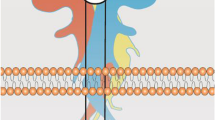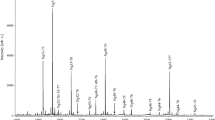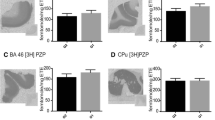Abstract
The uridine nucleotide-activated P2Y2, P2Y4 and P2Y6 receptors are widely expressed in the brain and are involved in many CNS processes, including those which malfunction in Alzheimer’s disease (AD). However, the status of these receptors in the AD neocortex, as well as their putative roles in the pathogenesis of neuritic plaques and neurofibrillary tangles, remain unclear. In this study, we used immunoblotting to measure P2Y2, P2Y4 and P2Y6 receptors in two regions of the postmortem neocortex of neuropathologically assessed AD patients and aged controls. P2Y2 immunoreactivity was found to be selectively reduced in the AD parietal cortex, while P2Y4 and P2Y6 levels were unchanged. In contrast, all three receptors were preserved in the occipital cortex, which is known to be minimally affected by AD neuropathology. Furthermore, reductions in parietal P2Y2 immunoreactivity correlated both with neuropathologic scores and markers of synapse loss. These results provide a basis for considering P2Y2 receptor changes as a neurochemical substrate of AD, and point towards uridine nucleotide-activated P2Y receptors as novel targets for disease-modifying AD pharmacotherapeutic strategies.




Similar content being viewed by others
References
Abbracchio MP, Burnstock G, Boeynaems JM, Barnard EA, Boyer JL, Kennedy C, Knight GE, Fumagalli M, Gachet C, Jacobson KA, Weisman GA (2006) International Union of Pharmacology LVIII: update on the P2Y G protein-coupled nucleotide receptors: from molecular mechanisms and pathophysiology to therapy. Pharmacol Rev 58:281–341
Arthur DB, Akassoglou K, Insel PA (2005) P2Y2 receptor activates nerve growth factor/TrkA signaling to enhance neuronal differentiation. Proc Natl Acad Sci USA 102:19138–19143
Auld DS, Kornecook TJ, Bastianetto S, Quirion R (2002) Alzheimer’s disease and the basal forebrain cholinergic system: relations to β-amyloid peptides, cognition, and treatment strategies. Prog Neurobiol 68:209–245
Behl C (2000) Apoptosis and Alzheimer’s disease. J Neural Transm 107:1325–1344
Braak H, Braak E (1991) Neuropathological stageing of Alzheimer-related changes. Acta Neuropathol (Berl) 82:239–259
Burnstock G (2007) Physiology and pathophysiology of purinergic neurotransmission. Physiol Rev 87:659–797
Butler D, Bendiske J, Michaelis ML, Karanian DA, Bahr BA (2007) Microtubule-stabilizing agent prevents protein accumulation-induced loss of synaptic markers. Eur J Pharmacol 562:20–27
Calvert JA, Atterbury-Thomas AE, Leon C, Forsythe ID, Gachet C, Evans RJ (2004) Evidence for P2Y1, P2Y2, P2Y6 and atypical UTP-sensitive receptors coupled to rises in intracellular calcium in mouse cultured superior cervical ganglion neurons and glia. Br J Pharmacol 143:525–532
Camden JM, Schrader AM, Camden RE, Gonzalez FA, Erb L, Seye CI, Weisman GA (2005) P2Y2 nucleotide receptors enhance α-secretase-dependent amyloid precursor protein processing. J Biol Chem 280:18696–18702
Cavaliere F, Amadio S, Angelini DF, Sancesario G, Bernardi G, Volonte C (2004) Role of the metabotropic P2Y4 receptor during hypoglycemia: cross talk with the ionotropic NMDAR1 receptor. Exp Cell Res 300:149–158
Cavaliere F, Nestola V, Amadio S, D’Ambrosi N, Angelini DF, Sancesario G, Bernardi G, Volonte C (2005) The metabotropic P2Y4 receptor participates in the commitment to differentiation and cell death of human neuroblastoma SH-SY5Y cells. Neurobiol Dis 18:100–109
Cole G, Dobkins KR, Hansen LA, Terry RD, Saitoh T (1988) Decreased levels of protein kinase C in Alzheimer brain. Brain Res 452:165–174
Counts SE, Mufson EJ (2005) The role of nerve growth factor receptors in cholinergic basal forebrain degeneration in prodromal Alzheimer disease. J Neuropathol Exp Neurol 64:263–272
Cross AJ, Crow TJ, Ferrier IN, Johnson JA (1986) The selectivity of the reduction of serotonin S2 receptors in Alzheimer-type dementia. Neurobiol Aging 7:3–7
Cummings JL, Back C (1998) The cholinergic hypothesis of neuropsychiatric symptoms in Alzheimer’s disease. Am J Geriatr Psychiatry 6:S64–S78
Flynn DD, Weinstein DA, Mash DC (1991) Loss of high-affinity agonist binding to M1 muscarinic receptors in Alzheimer’s disease: implications for the failure of cholinergic replacement therapies. Ann Neurol 29:256–262
Folstein MF, Folstein SE, McHugh PR (1975) Mini-mental state. A practical method for grading the cognitive state of patients for the clinician. J Psychiatr Res 12:189–198
Francis PT (2003) Glutamatergic systems in Alzheimer’s disease. Int J Geriatr Psychiatry 18:S15–S21
Francis PT, Sims NR, Procter AW, Bowen DM (1993) Cortical pyramidal neurone loss may cause glutamatergic hypoactivity and cognitive impairment in Alzheimer’s disease: investigative and therapeutic perspectives. J Neurochem 60:1589–1604
Francis PT, Palmer AM, Snape M, Wilcock GK (1999) The cholinergic hypothesis of Alzheimer’s disease: a review of progress. J Neurol Neurosurg Psychiatry 66:137–147
Gonzalez FA, Weisman GA, Erb L, Seye CI, Sun GY, Velazquez B, Hernandez-Perez M, Chorna NE (2005) Mechanisms for inhibition of P2 receptors signaling in neural cells. Mol Neurobiol 31:65–79
Hardy JA, Wester P, Winblad B, Gezelius C, Bring G, Eriksson A (1985) The patients dying after long terminal phase have acidotic brains; implications for biochemical measurements on autopsy tissue. J Neural Transm 61:253–264
Hellstrom-Lindahl E (2000) Modulation of β-amyloid precursor protein processing and τ phosphorylation by acetylcholine receptors. Eur J Pharmacol 393:255–263
Hope T, Keene J, Fairburn C, McShane R, Jacoby R (1997a) Behaviour changes in dementia. 2: Are there behavioural syndromes? Int J Geriatr Psychiatry 12:1074–1078
Hope T, Keene J, Gedling K, Cooper S, Fairburn C, Jacoby R (1997b) Behaviour changes in dementia. 1: Point of entry data of a prospective study. Int J Geriatr Psychiatry 12:1062–1073
Hope T, Keene J, Fairburn CG, Jacoby R, McShane R (1999) Natural history of behavioural changes and psychiatric symptoms in Alzheimer’s disease. A longitudinal study. Br J Psychiatry 174:39–44
Hussl S, Boehm S (2006) Functions of neuronal P2Y receptors. Pflugers Arch 452:538–551
Jacobs EH, Williams RJ, Francis PT (2006) Cyclin-dependent kinase 5, Munc18a and Munc18-interacting protein 1/X11α protein up-regulation in Alzheimer’s disease. Neuroscience 138:511–522
Kim SG, Soltysiak KA, Gao ZG, Chang TS, Chung E, Jacobson KA (2003) Tumor necrosis factor α-induced apoptosis in astrocytes is prevented by the activation of P2Y6, but not P2Y4 nucleotide receptors. Biochem Pharmacol 65:923–931
Kirvell SL, Esiri M, Francis PT (2006) Down-regulation of vesicular glutamate transporters precedes cell loss and pathology in Alzheimer’s disease. J Neurochem 98:939–950
Lai MK, Lai OF, Keene J, Esiri MM, Francis PT, Hope T, Chen CP (2001) Psychosis of Alzheimer’s disease is associated with elevated muscarinic M2 binding in the cortex. Neurology 57:805–811
Lai MK, Tsang SW, Alder JT, Keene J, Hope T, Esiri MM, Francis PT, Chen CP (2005) Loss of serotonin 5-HT2A receptors in the postmortem temporal cortex correlates with rate of cognitive decline in Alzheimer’s disease. Psychopharmacology (Berl) 179:673–677
Lanari A, Amenta F, Silvestrelli G, Tomassoni D, Parnetti L (2006) Neurotransmitter deficits in behavioural and psychological symptoms of Alzheimer’s disease. Mech Ageing Dev 127:158–165
Lanctot KL, Herrmann N, Mazzotta P (2001) Role of serotonin in the behavioral and psychological symptoms of dementia. J Neuropsychiatry Clin Neurosci 13:5–21
Lee CJ, Mannaioni G, Yuan H, Woo DH, Gingrich MB, Traynelis SF (2007) Astrocytic control of synaptic NMDA receptors. J Physiol 581:1057–1081
Lerch JP, Pruessner JC, Zijdenbos A, Hampel H, Teipel SJ, Evans AC (2005) Focal decline of cortical thickness in Alzheimer’s disease identified by computational neuroanatomy. Cereb Cortex 15:995–1001
Mann DM (1996) Pyramidal nerve cell loss in Alzheimer’s disease. Neurodegeneration 5:423–427
McLarnon JG, Choi HB, Lue LF, Walker DG, Kim SU (2005) Perturbations in calcium-mediated signal transduction in microglia from Alzheimer’s disease patients. J Neurosci Res 81:426–435
Meneses A, Hong E (1997) Role of 5-HT1B, 5-HT2A and 5-HT2C receptors in learning. Behav Brain Res 87:105–110
Mirra SS, Heyman A, McKeel D, Sumi SM, Crain BJ, Brownlee LM, Vogel FS, Hughes JP, van Belle G, Berg L (1991) The consortium to establish a registry for Alzheimer’s disease (CERAD). Part II. Standardization of the neuropathologic assessment of Alzheimer’s disease. Neurology 41:479–486
Moore D, Iritani S, Chambers J, Emson P (2000) Immunohistochemical localization of the P2Y1 purinergic receptor in Alzheimer’s disease. Neuroreport 11:3799–3803
Nicholas RA, Watt WC, Lazarowski ER, Li Q, Harden K (1996) Uridine nucleotide selectivity of three phospholipase C-activating P2 receptors: identification of a UDP-selective, a UTP-selective, and an ATP- and UTP-specific receptor. Mol Pharmacol 50:224–229
Nitsch RM, Slack BE, Wurtman RJ, Growdon JH (1992) Release of Alzheimer amyloid precursor derivatives stimulated by activation of muscarinic acetylcholine receptors. Science 258:304–307
Nitsch RM, Deng M, Growdon JH, Wurtman RJ (1996) Serotonin 5-HT2a and 5-HT2c receptors stimulate amyloid precursor protein ectodomain secretion. J Biol Chem 271:4188–4194
Pearson RC, Powell TP (1989) The neuroanatomy of Alzheimer’s disease. Rev Neurosci 2:101–121
Sadot E, Gurwitz D, Barg J, Behar L, Ginzburg I, Fisher A (1996) Activation of m1 muscarinic acetylcholine receptor regulates tau phosphorylation in transfected PC12 cells. J Neurochem 66:877–880
Selkoe DJ (2001) Alzheimer’s disease: genes, proteins, and therapy. Physiol Rev 81:741–766
Tsang SW, Lai MK, Kirvell S, Francis PT, Esiri MM, Hope T, Chen CP, Wong PT (2006) Impaired coupling of muscarinic M(1) receptors to G-proteins in the neocortex is associated with severity of dementia in Alzheimer’s disease. Neurobiol Aging 27:1216–1223
Tsang SW, Pomakian J, Marshall GA, Vinters HV, Cummings JL, Chen CP, Wong PT, Lai MK (2007) Disrupted muscarinic M1 receptor signaling correlates with loss of protein kinase C activity and glutamatergic deficit in Alzheimer’s disease. Neurobiol Aging 28:1381–1387
Tung EK, Choi RC, Siow NL, Jiang JX, Ling KK, Simon J, Bernard EA, Tsim KW (2004) P2Y2 receptor activation regulates the expression of acetylcholinesterase and acetylcholine receptor genes at vertebrate neuromuscular junctions. Mol Pharmacol 66:794–806
Whitehouse PJ, Price DL, Struble RG, Clark AW, Coyle JT, Delon MR (1982) Alzheimer’s disease and senile dementia: loss of neurons in the basal forebrain. Science 215:1237–1239
Wirkner K, Gunther A, Weber M, Guzman SJ, Krause T, Fuchs J, Koles L, Norenberg W, Illes P (2007) Modulation of NMDA receptor current in layer V pyramidal neurons of the rat prefrontal cortex by P2Y receptor activation. Cereb Cortex 17:621–631
Acknowledgments
This study is supported by the Wellcome Trust, UK. We thank Dr. Brendan McDonald for the collection and classification of the postmortem samples. S. Kirvell is the Edmond J. Safra Fellow at Wolfson CARD, King’s College London. In Singapore, the work was supported by the National Medical Research Council (NMRC/0932/2005) to M. K. P. Lai and a Faculty Start-up grant to C. P. Chen. M. K. P. Lai would like to thank Olivia H. J. Oon for valuable assistance.
Author information
Authors and Affiliations
Corresponding author
Rights and permissions
About this article
Cite this article
Lai, M.K.P., Tan, M.G.K., Kirvell, S. et al. Selective loss of P2Y2 nucleotide receptor immunoreactivity is associated with Alzheimer’s disease neuropathology. J Neural Transm 115, 1165–1172 (2008). https://doi.org/10.1007/s00702-008-0067-y
Received:
Accepted:
Published:
Issue Date:
DOI: https://doi.org/10.1007/s00702-008-0067-y




